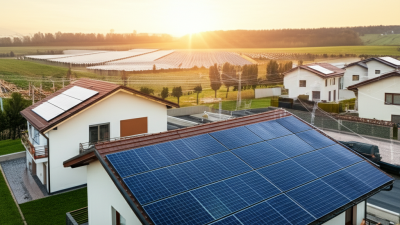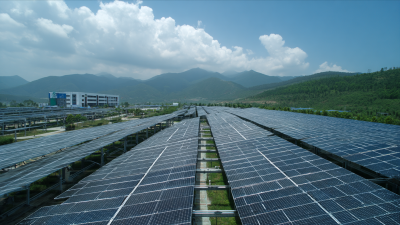
Blog
Harnessing Solar Power Solutions for a Sustainable Future and Energy Independence
In an era where the urgency for sustainable energy solutions has never been more pronounced, harnessing solar power solutions stands out as a pivotal approach towards achieving energy independence and environmental resilience. As global climate change accelerates, communities and nations alike are exploring how to effectively utilize abundant solar resources to reduce their carbon footprints and reliance on fossil fuels. This guide aims to unravel the practical ways in which individuals, businesses, and governments can adopt innovative solar power solutions to create a cleaner, greener future. By examining the latest technological advancements, economic incentives, and implementation strategies, we will provide actionable insights that empower stakeholders to integrate solar energy into their daily lives and policy frameworks. Together, we can illuminate the path towards sustainability and demonstrate how harnessing solar power solutions is not just a trend but a necessary shift for generations to come.

Identifying the Benefits of Solar Power for Sustainable Energy Solutions
Solar power has emerged as a pivotal solution in the quest for sustainable energy, offering numerous benefits that extend beyond mere energy production. According to the International Energy Agency, global solar energy capacity reached over 700 GW in 2020, reflecting a growth rate of approximately 26% from the previous year. This exponential increase showcases solar power's potential to significantly reduce greenhouse gas emissions, as the sector is projected to avoid over 2.1 billion tons of CO2 emissions annually by 2040 if current growth trends continue.
Moreover, solar energy fosters energy independence by reducing reliance on fossil fuels. The National Renewable Energy Laboratory estimates that a widespread adoption of solar could provide up to 20% of U.S. electricity by 2040. This shift not only strengthens national energy security but also promotes economic resilience through job creation in the renewable sector, which had approximately 3.4 million workers in 2021, according to the International Renewable Energy Agency. By leveraging these benefits, solar power establishes itself as a cornerstone of sustainable energy solutions, ultimately paving the way for a more environmentally friendly future.
Benefits of Solar Power for Sustainable Energy Solutions
This chart illustrates the key benefits of solar power in promoting sustainable energy solutions, emphasizing advantages such as cost savings, environmental impact, energy independence, and job creation.
Exploring Different Types of Solar Technology and Their Applications
Solar technology has evolved significantly, offering diverse solutions that cater to various energy needs. One prominent type is photovoltaic (PV) systems, which convert sunlight directly into electricity using semiconductor materials. PV systems can be deployed on residential rooftops, in commercial buildings, or as part of solar farms, making them versatile for both small-scale and large-scale energy production. Additionally, advancements in thin-film solar technology have made it possible to create lightweight and flexible solar panels, which are particularly useful for applications in unconventional spaces like vehicles and portable electronics.
Another innovative solar technology is concentrated solar power (CSP), which utilizes mirrors or lenses to concentrate sunlight onto a small area. This concentrated heat is then used to generate steam and drive a turbine, producing electricity. CSP systems are ideal for large installations in sunny regions, where they can harness solar energy efficiently and store thermal energy for use during non-sunny periods. Furthermore, solar water heating systems leverage the sun’s energy for heating water, providing a sustainable solution for residential hot water needs and reducing reliance on fossil fuels. These diverse applications illustrate how solar technology can play a crucial role in achieving energy independence and fostering a sustainable future.
Steps to Assess Your Home or Business for Solar Energy Integration
Assessing your home or business for solar energy integration is a crucial step towards embracing renewable energy solutions. Begin by evaluating your roof's orientation and angle; ideally, it should face south and have minimal shading from trees or other structures. This maximizes sunlight exposure and enhances energy production. Additionally, consider conducting an energy audit to determine current consumption patterns and potential areas for efficiency improvements. This step will provide valuable insights into the appropriate size and capacity of the solar system required to meet your needs.
Next, research local incentives and regulations that may support your solar integration journey. Many regions offer tax credits, rebates, or financing options that can significantly alleviate the initial investment cost. It’s also essential to consult with professionals to explore system designs and installation methods tailored to your specific property. By systematically assessing these elements, you can make an informed decision about transitioning to solar energy, contributing to a more sustainable future and fostering energy independence.
Financial Incentives and Funding Options for Solar Power Projects
Financial incentives play a crucial role in promoting solar power projects, making sustainable energy more accessible to individuals and businesses alike. Governments worldwide recognize the importance of transitioning to renewable energy sources, offering tax credits, rebates, and grants to reduce the initial costs of installation. For instance, federal tax credits in the United States allow homeowners to deduct a significant percentage of the cost of solar systems from their federal taxes, which can prompt a considerable increase in adoption rates. Additionally, many states provide their own incentives, creating a layered approach to financial support that can further enhance affordability.
Funding options for solar power projects have also expanded, supported by both public and private financing mechanisms. Through initiatives like green bonds and community solar programs, projects can attract investment and reduce financial barriers for underserved communities. Furthermore, partnerships with financial institutions offer innovative loan products that cater to solar investments, allowing for flexible payment structures aligned with energy savings. Such funding solutions not only help individual projects thrive but also contribute to broader energy independence goals by fostering a robust solar market that can sustain its growth and adoption over time.
Harnessing Solar Power Solutions for a Sustainable Future and Energy Independence - Financial Incentives and Funding Options for Solar Power Projects
| Incentive Type | Description | Eligibility Criteria | Potential Savings | Funding Source |
|---|---|---|---|---|
| Tax Credit | A dollar-for-dollar reduction in the amount of taxes owed. | Homeowners and businesses with solar installations. | Up to 26% of the solar power system cost. | Federal Government |
| Rebates | Cash incentives for installing solar energy systems. | Varies by state/local programs. | $500 to $3,000 depending on the system size. | State/Local Governments |
| Financing Programs | Low-interest loans or other financing options to cover installation costs. | Homeowners and small businesses. | Interest rates as low as 2%. | Private Institutions/NGOs |
| Grants | Funds that do not need to be repaid, typically for specific projects. | Non-profits, researchers, and local governments. | Up to $50,000 for eligible projects. | Federal/State Agencies |
| Net Metering | Allows solar energy producers to sell excess power back to the grid. | Residential and commercial solar energy producers. | Potentially offset monthly utility bills significantly. | Utility Companies |
Best Practices for Maintaining and Optimizing Solar Power Systems
In the pursuit of a sustainable future, optimizing solar power systems is essential. With the proliferation of solar technologies, maintaining their efficiency and performance becomes crucial. The integration of artificial intelligence (AI) in managing solar energy production offers significant benefits. AI can help predict maintenance needs, enabling proactive interventions that extend the lifespan and efficiency of solar installations.
Tip 1: Regularly clean your solar panels to maximize their energy output. Utilizing advanced cleaning methods, such as autonomous cleaning robots, can significantly enhance performance without the risks associated with manual cleaning. This investment can lead to substantial long-term savings and increased energy independence.
Additionally, monitoring systems play a vital role in maintaining optimal operation. Platforms that offer real-time insights into performance metrics can identify issues before they escalate. This proactive approach helps ensure that solar power systems function at their best, significantly reducing downtime.
Tip 2: Implement predictive maintenance strategies using IoT devices and data analytics to track system performance continuously. This data-driven approach enables informed decision-making that optimizes energy production and minimizes unexpected failures. By harnessing these best practices, solar power users can contribute to a more sustainable and energy-independent future.
Related Posts
-

How to Maximize Energy Efficiency with Solar Panel Power Solutions
-

Ultimate Checklist for Choosing the Right Solar Power Solutions for Your Business Needs
-

Navigating Industry Standards: Challenges in Sourcing the Best Green Solar Panels Globally
-

Uncover the Excellence of Best Solar Engineering from Chinas Leading Manufacturers
-

Achieving Export Certification for the Best Solar Structures: A Step-by-Step Guide
-

Evaluating the Ecological Benefits of Green Power vs Traditional Energy Sources: A Comprehensive Comparison